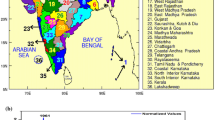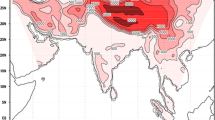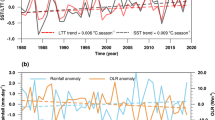Abstract
In this study, we examine the transitions in the monsoon phases (onset, active, break and the withdrawal) during an entire monsoon season. This makes use of a host of observational tools that come from GPM (Global Precipitation Measurement) and TRMM (Tropical Rainfall Measuring Mission) satellites for precipitation estimates, the vertical structure of rain, hydrometeors and cloud types from TRMM and CloudSat datasets. During onset, the mean moisture convergence, especially over west and south-west coast of India is 2 × 10−4 kg m−1 s−1; however, it carries much higher value of >4 × 10−4 kg m−1 s−1 during the active phase over central eastern India. Much lesser moisture convergence (<1 × 10−4 kg m−1 s−1) is noted over Western Ghats area during the break phase. However, there are northeasterly moisture fluxes present over southern part of India during withdrawal phase. The tall cumulonimbus clouds that extend out to 16 km are illustrate during onset, the active phase is dominated by alto stratus and nimbostratus type clouds that are somewhat shallower. In general, we noted an absence of such clouds during the break and the withdrawal phases. Those structures were consistent in a number of derived fields such as the moisture convergence, moisture fluxes, the energy conversions between the rotational and the divergent kinetic energy and the corresponding phases of the intra-seasonal oscillations.
















Similar content being viewed by others
References
Bounoua L and Krishnamurti T N 1993 Influence of soil moisture on the Sahelian climate prediction I; Meteorol. Atmos. Phys. 52 183–203.
Cadet D L and Greco S 1987a Water vapor transport over the Indian Ocean during the 1979 summer monsoon. Part I: Water vapor fluxes; Mon. Weather Rev. 115 653–663.
Cadet D L and Greco S 1987b Water vapor transport over the Indian Ocean during the 1979 summer monsoon. Part II: Water vapor Budgets; Mon. Weather Rev. 115 2358–2366.
Chakraborty A and Nanjundiah R S 2012 Space–time scales of northward propagation of convection during boreal summer; Mon. Weather Rev. 140 3857–3866.
Dee D P et al. 2011 The ERA-Interim reanalysis: Configuration and performance of the data assimilation system; Q. J. Roy. Meteor. Soc. 137 553–597.
Deshpande N R and Goswami B N 2014 Modulation of the diurnal cycle of rainfall over India by intraseasonal variations of Indian summer monsoon; Int. J. Climatol. 34 793–807.
Dudhia J 1989 Numerical study of convection observed during the Winter Monsoon Experiment using a mesoscale two-dimensional model; J. Atmos. Sci. 46 3077–3107.
Hazra A, Chaudhari H S, Saha S K and Pokhrel S 2017 Effect of cloud microphysics on Indian summer monsoon precipitating clouds: A coupled climate modeling study; J. Geophys. Res. Atmos. 122 3786–3805, https://doi.org/10.1002/2016jd026106.
Hong Song-You, Yign Noh and Jimy Dudhia 2006 A new vertical diffusion package with an explicit treatment of entrainment processes; Mon. Weather Rev. 134 2318–2341.
Huffman G J et al. 2007 The TRMM Multi satellite Precipitation Analysis: Quasi-global, multiyear, combined-sensor precipitation estimates at fine scale; J. Hydrometeor. 8 38–55, https://doi.org/10.1175/jhm560.1.
Huffman G J, Adler R F, Bolvin D T and Nelkin E J 2010 The TRMM Multi-Satellite Precipitation Analysis (TMPA); In: Satellite Rainfall Applications for Surface Hydrology (eds) Hossain F and Gebremichael M, Springer, pp. 3–22.
Huffman G J et al. 2015a NASA Global Precipitation Measurement (GPM) Integrated Multi-satellitE Retrievals for GPM (IMERG). Algorithm Theoretical Basis Doc., version 4.5, 26p., http://pmm.nasa.gov/sites/default/files/document_files/IMERG_ATBD_V4.5.pdf.
Huffman G J, Bolvin D T and Nelkin E J 2015b Integrated Multi-satellitE Retrievals for GPM (IMERG) technical documentation; NASA Doc., 47p., http://pmm.nasa.gov/sites/default/files/document_files/ IMERG_doc.pdf.
Janowiak J E, Joyce R J and Yarosh Y 2001 A real-time global half-hourly pixel-resolution infrared dataset and its applications; Bull. Am. Meteor. Soc. 82 205–217, https://doi.org/10.1175/1520-0477(2001)082,0205:artghh.2.3.co;2.
Joshi P C, Simon B and Desai P S 1990 Atmospheric thermal changes over the Indian Ocean using satellite data, physical processes in atmospheric models; Int. J. Climatol. 10 49–56.
Kain J S and Fritsch J M 1993 Convective parameterization for mesoscale models: the Kain–Fritsch scheme; In: The Representation of Cumulus Convection in Numerical Models (eds) Emanuel K A and Raymond D J, chap. 16, vol. 24, AMS Press, Boston.
Kiran R V, Rajeevan M, Rao S V B and Prabhakara Rao N 2009 Analysis of variations of cloud and aerosol properties associated with active and break spells of Indian summer monsoon using MODIS data, Geophys. Res. Lett. 36 L09706, https://doi.org/10.1029/2008gl037135.
Krishnamurti T N, Kumar V, Simon A, Thomas A, Bhardwaj A, Das S, Senroy S and Roy Bhowmik S K 2016 March of buoyancy elements during extreme rainfall over India; Clim. Dyn. 48(5) 1931–1951.
Krishnamurti T N and Biswas M K 2006 Transitions in the surface energy balance during the life cycle of a monsoon season; J. Earth Syst. Sci. 115(2) 185–201.
Krishnamurti T N, Bedi H S, Hardiker V and Watson-Ramaswamy L 2006 An Introduction to Global Spectral Modeling; Oxford University Press, Springer, New York, Chap. 10, 213–251, https://doi.org/10.1007/0-387-32962-5.
Krishnamurti T N and Kishtawal C M 2000 A pronounced continental-scale diurnal mode of the Asian summer monsoon. Mon. Weather Rev. 128 462–473.
Krishnamurti T N and Subrahmanyam D 1982 The 30–50 day mode at 850 hPa during MONEX; J. Atmos. Sci. 39 2088–2095.
Krishnamurti T N and Ramanathan Y 1982 Sensitivity of the monsoon onset to differential heating; J. Atmos. Sci. 39 1290–1306.
Krishnamurti T N, Ardanuy P, Ramanathan Y and Pasch R 1981 On the onset vortex of the summer monsoon; Mon. Weather Rev. 109 344–363.
Kulkarni A, Kripalani R, Sabade S and Rajeevan M 2011 Role of intra-seasonal oscillations in modulating Indian summer monsoon rainfall; Clim. Dyn. 36 1005–1021.
Lin Y-L, Rareley R D and Orville H D 1983 Bulk parameterization of the snow field in a cloud model; J. Appl. Meteor. 22 1065–1092.
Liu Z 2015 Comparison of Integrated multisatellite retrievals for GPM (IMERG) and TRMM multisatellite precipitation analysis (TMPA) monthly precipitation products: Initial results; J. Hydrometeor. 17 777–790.
Mlawer E J, Taubman S J, Brown P D, Iacono M J and Clough S A 1997 Radiative transfer for inhomogeneous atmosphere: RRTM, a validated correlated-k model for the longwave; J. Geophys. Res. 102 16,663–16,682.
Nakagawa K, Yoshida N and Higashiuwatoko T 2011 PR V7 2A25 evaluation using the conventional radar in Japan; TRMM Doc., JAXA, 11p.
Neeck S P, Kakar R, Azarbarzin A, Hou A and Skofronick-Jackson G 2014 Global Precipitation Measurement (GPM) Launch, Commissioning, and Early Operations. Sensors, Systems, and Next-Generation Satellites XVIII Book Series; Proc. SPIE, https://doi.org/10.1117/12.2069868.
Pillai P A and Sahai A K 2014 Moist dynamics of active/break cycle of Indian summer monsoon rainfall from NCEPR2 and MERRA reanalysis; Int. J. Climatol. 34 1429–1444.
Rajeevan M, Bhate J, Kale J D and Lal B 2005 Development of a high resolution daily gridded rainfall data for the Indian region. Met. Monogr. Climatol. 22 2005.
Rajeevan M, Gadgil S and Bhate J J 2010 Active and break spells of the Indian summer monsoon; J. Earth Syst. Sci. 119 229–247.
Rao Y P 1976 Meteorological Monograph Synoptic Meteorology No. 1/1976, Southwest Monsoon, India Meteorological Department.
Revadekar J V, Kumar K R, Tiwari Y K and Valsala V 2016 Variability in AIRS CO2 during active and break phases of Indian summer monsoon; Sci. Total Environ. 541 1200–1207.
Roja Raman M, Jagannadha Rao V V M, Venkat Ratnam M, Kishore Kumar G, Narendra Babu A, Vijaya Bhaskara Rao S, Prabhakara Rao N and Narayana Rao D 2008 Atmospheric circulation during active and break phases of Indian summer monsoon: A study using MST radar at Gadanki (13.5°N, 79.2°E); J. Geophys. Res. 113 D20124, https://doi.org/10.1029/2008jd010341.
Rolph G, Stein A and Stunder B 2017 Real-time Environmental Applications and Display sYstem: READY; Environ. Model. Softw. 95 210–228, https://doi.org/10.1016/j.envsoft.2017.06.025.
Sahu D K, Dash S K and Bhan S C 2014 Impact of surface observations on simulation of rainfall over NCR Delhi using regional background error statistics in WRF-3DVAR model; Meteorol. Atmos. Phys. 125 17–42, https://doi.org/10.1007/s00703-014-0320-x.
Simpson J, Kummerow C, Tao W K and Adler R F 1996 On the tropical rainfall measuring mission (TRMM); Meteorol. Atmos. Phys. 60 19–36.
Stein A F, Draxler R R, Rolph G D, Stunder B J B, Cohen M D and Ngan F 2015 NOAA’s HYSPLIT atmospheric transport and dispersion modeling system, Bull. Am. Meteor. Soc. 96 2059–2077, https://doi.org/10.1175/BAMS-D-14-00110.1.
Stephens G L et al. 2002 The CloudSat mission and the A-Train: A new dimension of space-based observations of clouds and precipitation; Bull. Am. Meteor. Soc. 83(12) 1771–1790.
Tao W-K et al. 2009 Goddard multi-scale modeling systems with unified physics; Ann. Geophys. 27 3055–3064.
Tao W-K, Wu D, Lang S, Chern J-D, Peters-Lidard C, Fridlind A and Matsui T 2016 High-resolution NU-WRF simulations of a deep convective-precipitation system during MC3E: Further improvements and comparisons between Goddard microphysics schemes and observations; J. Geophys. Res. Atmos. 121 1278–1305, https://doi.org/10.1002/2015jd023986.
Waliser D E 2006 Intra-seasonal variability; In: The Asian Monsoon (ed.) Bin Wang, Ch. 5, pp. 203–257.
Waliser D E, Stern W, Schubert S and Lau K M 2003 Dynamic predictability of intraseasonal variability associated with the Asian summer monsoon; Q. J. Roy. Meteorol. Soc. 129 2897–2925.
Wonsick M M, Pinker R T and Govaerts Y 2009 Cloud variability over the Indian monsoon region as observed from satellites; J. Appl. Meteor. Climatol. 48 1803–1821.
Acknowledgements
This work was supported by the research grant from NASA/PMM grant No. NNX16AD83G. The authors gratefully acknowledge NASA for TRMM, GPM/IMERG and CloudSat products and NCEP/NCAR for providing the GFS data for model simulation. We are thankful to Prof. Vasu Misra, Department of Earth, Ocean and Atmospheric Science, Florida State University for his feedback and helpful discussions to improve this manuscript. We also thank the anonymous reviewers for their valuable comments and suggestions.
Author information
Authors and Affiliations
Corresponding author
Additional information
Communicated by N V Chalapathi Rao
Appendix
Appendix
The vertically integrated moisture transport vectors and convergence of flux of moisture (MFC) transport are estimated from the following formulations:
is the total column zonal flux of moisture.
is the total column meridional flux of moisture.
representation of vertically integrated moisture transport vector.
convergence of vertically integrated moisture transport.
Here, \( g \) is the acceleration due to gravity, \( \vec{U} \) and \( \vec{V} \) are the zonal and meridional wind components, \( \vec{\nabla } \) is the del operator, and \( q \), the moisture parameter.
Rights and permissions
About this article
Cite this article
Sahu, D.K., Krishnamurti, T.N. & Kumar, V. Elucidating intra-seasonal characteristics of Indian summer monsoon. Part-I: Viewed from remote sensing observations, reanalysis and model datasets. J Earth Syst Sci 129, 29 (2020). https://doi.org/10.1007/s12040-019-1276-5
Received:
Revised:
Accepted:
Published:
DOI: https://doi.org/10.1007/s12040-019-1276-5




